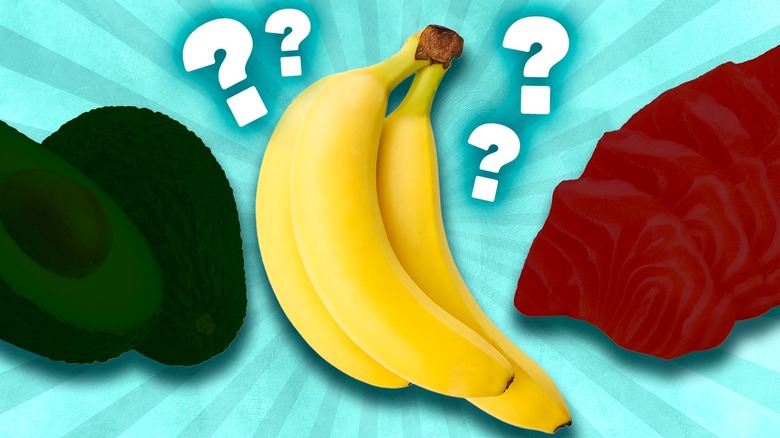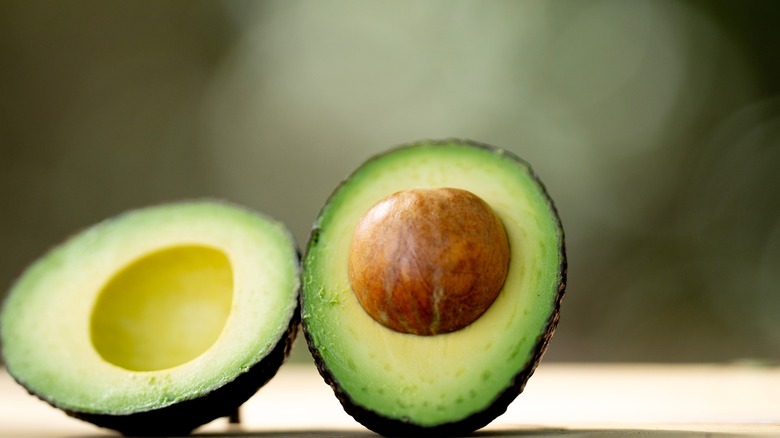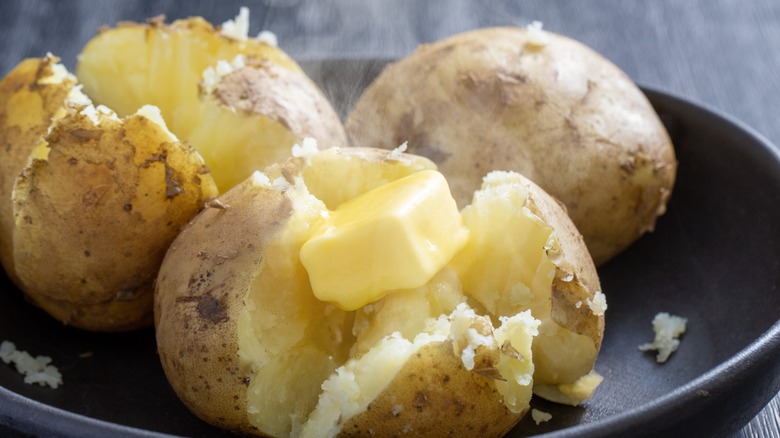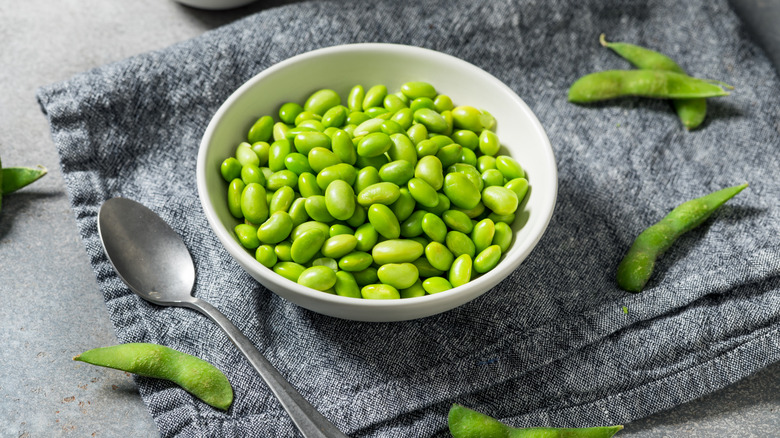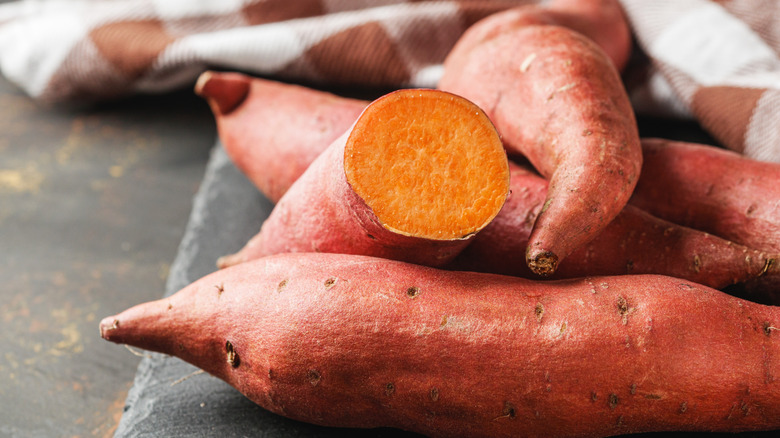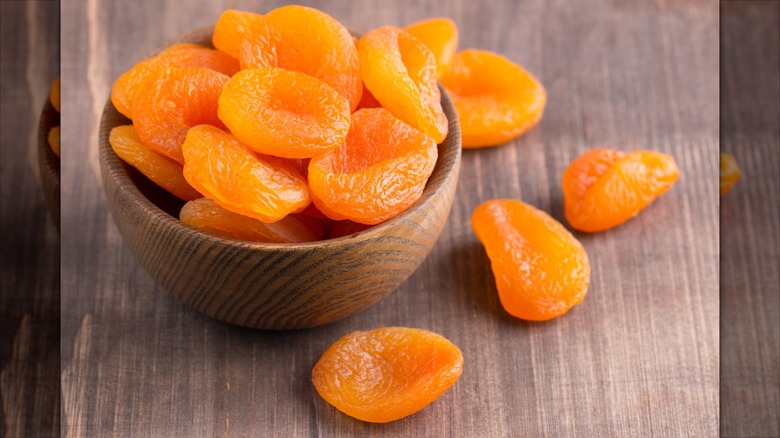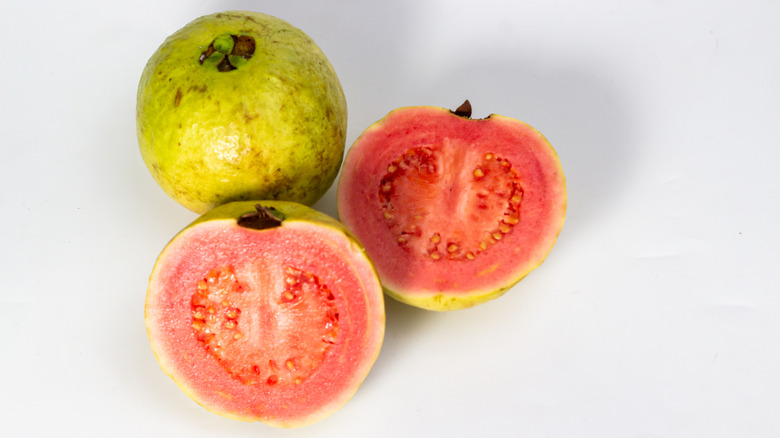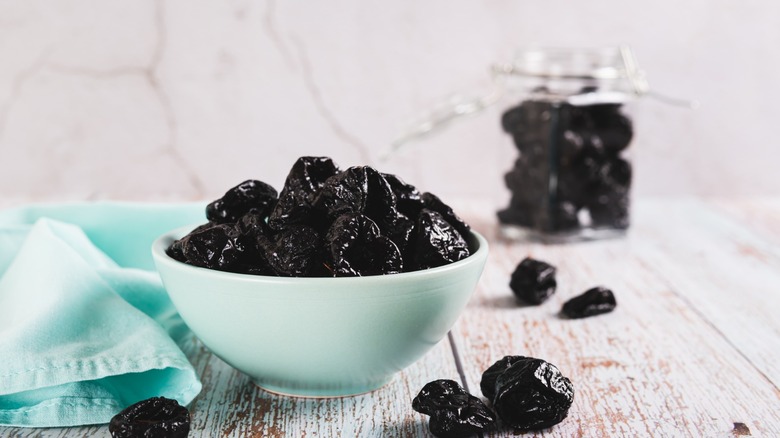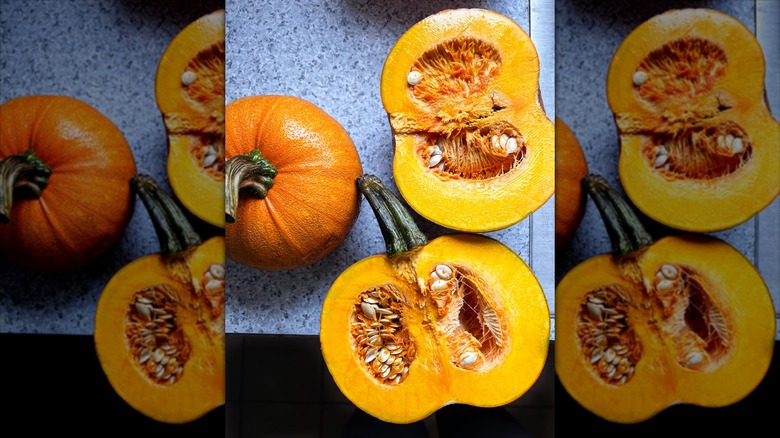11 Foods With More Potassium Than Bananas
Let's talk potassium. Mainly, the fact that potassium is just not getting the love it deserves. Too often overshadowed by "superstars" like protein or fiber, potassium's relegation to supporting character status doesn't make sense when you consider the fact that it literally supports several of the processes that keep your body functional on a daily basis. From helping to regulate your fluids to even helping you keep your heart rate steady, potassium is an unsung hero — and its time in the shadows ends today.
Most people immediately think of bananas when it comes to foods that contain potassium. Honestly, we think limiting ourselves to that lone yellow boomerang-shaped fruit is, well, bananas. While a medium banana does offer a respectable average of 425 milligrams, it's far from the only contender in the potassium game.
The truth is, the world of potassium-rich foods is vast, colorful, and surprisingly delicious. This article explores 11 foods with more potassium than bananas. You just might be shocked by a few of them. Not only will you discover new nutrition heavy-hitters, but we'll also show you simple and yummy ways to work each one into your daily meals, snacks, and on-the-go routine.
Avocado
If you're measuring potassium solely by the numbers, think of it like a potassium pageant, where avocados would score a solid 10. Bananas, bless their yellow-bellied hearts, would be lucky if they scored a five. A medium avocado supplies over 900 milligrams of potassium, which makes this creamy green thing an absolute super fruit in the nutrient world. That means even half of an avocado can provide more potassium than an entire banana.
It also helps that avocados contain a whole load of other bonus nutrients, such as fiber, vitamin C, and vitamin E. Often nicknamed "alligator pears," avocados have earned global fame for their buttery texture and mild flavor. And their versatility is off the charts. You could say they could maybe win the Miss Congeniality category in the potassium pageant, able to play nice with many a recipe, equally at home smashed into guacamole, slathered on slices of golden toast, blended into dressings, or eaten straight from the skin with a sprinkling of salt and a spoon.
Speaking of versatility in recipes, the neutral, mellow flavor profile of avocados makes them a dream ingredient in both savory dishes and, surprisingly, sweet baked goods. When shopping to add them to your next meal, here is the inside scoop on how to pick the best avocados at the grocery store.
Salmon
If you've been relying on only bananas for your potassium fix, give salmon a moment to proudly flex its fins. Just half of a salmon fillet delivers roughly 684 mg of potassium. That means a full fillet would provide over 1,300 milligrams, firmly placing this mega-nutrient-rich fish well ahead of bananas in the fight for the potassium prize. That's before we even broach the subject of all the bonus benefits that make salmon one of the most nutrient-filled foods on earth.
Beyond its bragging rights in the potassium corner, salmon is famous for being packed to the gills (literally) with high-quality protein and omega-3 fatty acids, you know, those heart-supporting, inflammation-taming fats your doctor is always nagging you about including in your daily diet? Yeah, those. The FDA actually encourages eating two servings of fish rich in omega-3 per week, and salmon definitely fits that bill. Craving inspiration on how to meet that goal? You're in luck. Salmon practically cooks itself, but if you're fishing for fresh ideas, we've got you covered. Check out these simple salmon ideas to showcase nature's perfect fish.
Baked potato
We have already established that bananas get all the hype, but potatoes are spuds that refuse to be shunted into the shadows when it comes to receiving their due buzz on the nutrition front. Compared to the medium banana's paltry 425 milligrams of potassium, a single medium russet potato (with the skin on, although you'll find potassium in both the skin and flesh) delivers nearly 900 milligrams. That's more than double what a banana brings to the table. A large baked potato weighing around 300 grams can provide as much as 1,600 milligrams of potassium.
And while we are standing on this little soapbox, let's discuss how potatoes have, somewhere along the line, earned an unwarranted reputation for being "unhealthy." Personally, we think that's totes unfair, because the truth is, the potato itself is incredibly nutritious! Instead, it's usually the bad company this tuber keeps — think copious amounts of oil, cheese, bacon, and butter, oh my! — that tips the spud scales into not-so-healthy territory.
Left to their own devices (aka in their natural form), potatoes are definitely more Glinda the Good, providing fiber, vitamin C, magnesium, iron, vitamin B6, folate, and, yes, that massive dose of our old pal, potassium. The key is preparation, with baking or roasting trumping frying or drowning these tubers in heavy toppings. Not wanting to go through the effort at home? No worries! There are plenty of restaurant chains serving delicious baked potatoes to meet your potassium goals.
Acorn squash
When you stack acorn squash against the banana baseline of 425 milligrams of potassium, this winter squash is one gourd that wipes the court with its more commonly consumed contender. A single cooked cup of acorn squash provides about 896 milligrams of potassium, making that one scoreboard of shame for a monkey's favorite fruity friend.
While technically a winter squash, it may surprise you to learn that acorn squash is one of many squash varieties available in most stores year-round. Its dark green or orange shell and its paler, golden-orange interior hide a mild, sweet flavor that becomes richer when roasted. Its nutritional profile is pretty impressive beyond just potassium, as it also adds a decent amount of fiber and other vitamins and minerals to your meal.
Now that we have outlined the incredible benefits of adding acorn squash into your daily mix, you might be curious and need some help about where to begin. Don't worry, there's a whole world of squash waiting for you! The acorn squash you pick up from the grocery store will pair well with both savory and sweet additions, ranging from vegetables to butter and brown sugar.
Soybeans and edamame
While bananas give you 425 milligrams of potassium, soybeans (especially in their edamame form) deliver a surprisingly more potent punch. Just half a cup of edamame contains around 338 milligrams of the coveted nutrient, meaning if you snack on enough of the beans, you'll be chowing down on an easy way to boost your daily potassium intake.
What many may not realize is that edamame are simply young, unripe soybeans harvested before they harden. While edamame has been a beloved go-to snack and ingredient in the likes of Japan and China for a long time, its popularity in the U.S. has only started to skyrocket relatively recently. Served steamed or boiled, shelled or in the pod, edamame has a slightly sweet, nutty taste, making it a particularly perfect snack and appetizer. You may have spotted them on the menu at your local sushi joint, their presence sparking joy because they are just so simple, light, satisfying, and fun to eat.
These little green gems are also surprisingly low in calories, with just 188 calories per cup, and packed with plant-based protein, fiber, and minerals. After such rave reviews, you must be ready to embrace the pod?
Sweet potato
We have already featured the fab potassium breakdown of russet baked potatoes, but sweet potatoes' potassium game is also quite strong. A medium-sized, baked sweet potato typically contains around 450 milligrams. That places it slightly ahead of bananas in the potassium race, often surpassing them depending on size. And let's be honest, who wants a puny lil potato? Most American spud servings, especially when served at restaurants, more than match a teeny weeny banana's unpeeled presentation. Just remember not to remove the skin. That's where you'll find a lot of the sweet potato's nutritional benefits.
Potassium is just the beginning of what this vibrant tuber delivers. These naturally sweet starches offer fiber, vitamin C, iron, and an exceptional amount of vitamin A. We also adore advocating for sweet potatoes because they are so diverse, working well in both savory and sweet dishes, catering to a variety of niches. To keep them nutritious, a healthy mode of preparation is paramount. Just as their russet cousins, roasting and baking them is best, while eschewing the heavy toppings so often heaped upon them (we are looking at you, butter and Thanksgiving marshmallows!) Ready to get cooking with these golden-orange goodies? There are plenty of stellar sweet potato recipes out there to get you started.
Dried apricots
Dried apricots may look small and insignificant, but when it comes to going toe-to-toe in a potassium contest, they offer way bigger benefits than bananas. A medium banana comes in at 425 milligrams, while dried apricots deliver a jaw-dropping 378 milligrams in just a ¼-cup serving. That means a tiny handful puts you nearly neck-and-neck with a whole banana, and if you go by weight, apricots absolutely slay that scaled comparison.
These chewy, amber-hued dried fruits pack an impressive nutritional punch, particularly because they are basically mini super-concentrated versions of the fresh fruit. And you know what that means — a whole lot more punch in each (albeit smaller) portion. These dried beauties are sweeter than their fresh versions as dehydration removes water but leaves the natural sugars behind. That means anyone keeping an eye on their sugar intake may want to be careful with dried apricots or any dried fruit.
There are some health benefits to eating dried apricots beyond their potassium content. A study published in Nutrition Research (via the National Library of Medicine) found that those who included small servings of dried fruit daily in their diets tended to have better overall nutrient intake and lower intakes of added sugars, fats, and alcohol. Besides the potassium it provides, another superpower of dried or dehydrated fruits is that they're one of the best foods to prepare before a winter storm.
Guava
When it comes to potassium bragging rights, guava can gab with good reason. While the trusty old banana may bring a decent 425 milligrams to the mix, just 1 cup of guava delivers an astounding 688 milligrams. Guava also comes with several more nutrients to power up its potassium punch. It's known to contain a wealth of vitamin C (four times more than oranges, in fact), as well as vitamin A, which means guava can even show your peepers some love by supporting healthy vision.
If digestion is your personal battlefield, guava's impressive dietary fiber content (a hefty 9 grams per cup) helps keep things moving while supporting steady blood sugar levels by slowing down the body's absorption of sugar. Add to this the fact that guava is naturally low in saturated fat and cholesterol, and you've got a nutrient-dense, potassium-filled powerhouse worthy of a spot in your regular rotation. With all that good news and praise being heaped on the good ole guava, chances are you are ready to add a bit more of it to your world.
Watermelon
Watermelon may be the star of summer picnics, but it's also the stealthy MVP when it comes to potassium. While your standard banana may contribute a decent 425 milligrams of potassium, just two generous wedges of watermelon (about ⅛ of the melon) deliver a hearty 640 milligrams. That's a generous percentage of your daily potassium needs, all wrapped up in hydrating, refreshing, and oh-so-naturally sweet slices of melon paradise.
One of the best things about watermelon is how much volume you get for so few calories, thanks to the fruit's high water content. It's one of those foods that fills you up without taking a chunk out of your daily recommended calorie intake. It's also one of the easiest fruits to incorporate into your routine, eaten as is, easily blended into smoothies, cubed into salads, or even frozen into icy fruit pops.
But here's the challenge every watermelon lover knows all too well: finding the right one. Fortunately, there are a few foolproof tricks that can help you pick out the best watermelon at the store, such as checking for a big yellow or orange-colored spot or finding one that sounds hollow when tapped.
Prunes
Prunes may not be the first snack you reach for when your stomach starts to rumble, and fair enough. But when it comes to holding their own in the potassium-rich food department, they absolutely deserve their due reverence. These wrinkly beauties, in all their shrivelled glory, take the 425-milligram total that makes bananas such an iconic potassium-rich snack and absolutely obliterate it.
A serving of approximately eight prunes can surpass that offering, depending on their size. And if you prefer drinking your nutrients, a cup of prune juice packs roughly 700 milligrams of potassium into your glass, basically blowing banana levels out of the water. But potassium is only part of their charm, and only one of the reasons why we — not to mention nutritionists — are big fans of the dried fruit.
Ready for reason number two (you'll get why we think we're hilarious for that in a hot second)? Prunes are also famously high in dietary fiber, which helps keep things flowin' in the bathroom department. That is the nice way of putting it, but you know what we're talking about!
Pumpkin
Pumpkin may dominate fall decor and be among the prime players on the Thanksgiving menu roster, but nutritionally, it deserves year-round celebration. A banana gives you 425 milligrams of potassium, while 1 cup of canned pumpkin packs in around 500 milligrams. Some servings may contain even more potassium, depending on how they are prepared. That means your favorite autumn food quietly outperforms bananas in this essential mineral, and you don't have to wait for pumpkin spice season to spoon up, or fork over, all those benefits.
Beyond its high potassium profile, pumpkin is also low in calories and rich in vitamin A, meaning your eyes will thank you for eating up this glorious gourd. And just like our recently raved-about prunes, pumpkin provides a generous amount of fiber as well (and you already know how that is quite the moving argument for its place in your recipe Rolodex).
Pumpkin is quite versatile, amenable to baked goods (hello, spiced pumpkin bread), soups, stir-fries, and much more. And, of course, fall menus across the country always find creative — and sometimes relatively wild — ways to elevate pumpkin into unique dishes.
